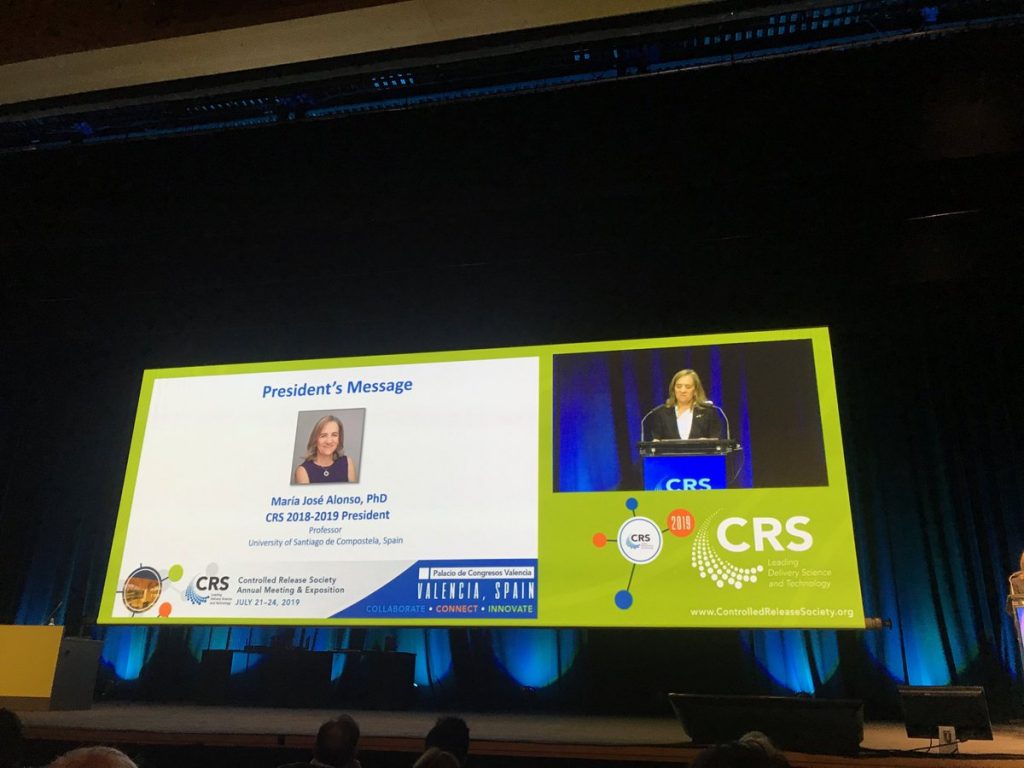Professionals from all over the world from different sectors present in Valencia the scientific and technological advances in controlled drug release, diagnostic strategies, as well as the latest more accurate and safer treatments for patients
Santiago de Compostela – July 22, 2019.- The Palacio de Congresos de Valencia hosts from Saturday, July 20 to Wednesday, July 24, the 46th Annual Meeting of the “Controlled Release Society” (CRS), the most relevant scientific society worldwide in controlled release of drugs, including nanomedicine, chaired by the researcher and professor of Pharmaceutical Technology at the University of Santiago de Compostela (USC), María José Alonso, King Jaume I Award in New Technologies in 2011.
With about 50 years of history and more than 1,000 members, the International Controlled Release Society (CRS) holds its annual congress for the first time in Spain, in the city of Valencia. Two Spanish scientists: María José Alonso, from the USC, and María Jesús Vicent, from the Príncipe Felipe Research Center (CIPF) in Valencia are in charge of this event.
CRS is a non-profit scientific society that brings together a broad spectrum of scientists, engineers, pharmacists, doctors, chemists, biologists and biotechnologists from the academic, research and industrial sectors. “The partners of CRS create extraordinary value in the field of controlled release of drugs and other biological substances. Many of their inventions have reached the clinic and provide extraordinary benefits in the treatment of numerous diseases”, says María José Alonso.
For the first time in its history, the Scientific Society is chaired by a Spanish woman, María José Alonso, a professor at the University of Santiago de Compostela, who has been a member of the board of directors since 2013. María José Alonso has been a pioneer in Spain in the field of Pharmaceutical Nanotechnology (https://www.usc.gal/grupos/mjalonsolab/) and is an international benchmark, as evidenced by her membership in the United States Academy of Medicine.
The person in charge of the scientific organization of the Congress is María Jesús Vicent, head researcher of the Therapeutic Polymers Laboratory of the CIPF, a reference in the development of polymeric nanopharmaceuticals: “It is an honor to receive in Valencia one of the reference conferences worldwide where the latest technological advances in advanced therapies to address unmet medical needs will be discussed, from metastatic cancers, neurodegenerative diseases, pain, or how to treat diseases like AIDS. In addition, it provides many possibilities for interaction between young researchers and the most relevant scientists in this field, always with a clear vision: our ultimate goal is the patient”.
Both, María Jesús Vicent and María José Alonso, are part of the College of Fellows of the American Institute for Medical and Biological Engineering (AIMBE). AIMBE is a non-profit organization, based in Washington D.C. (USA), representing 50,000 professionals, recognized leaders, engineers, entrepreneurs and innovators in the area of medical and biological engineering.
New materials and new technologies to provide new drugs
During the CRS Anual Meeting, international experts present their advances in new treatments with cell therapies, new biomarkers, new biomaterials, new drugs, advances in regenerative medicine, biomachromolecules, new generations of antibiotics, polymers and the latest in specific treatments in areas such as cancer, autoimmune diseases, pediatrics and neurological pathologies. Among them, 20 researchers from the University of Santiago de Compostela present their work in the field of drug and nanomedicine release.
Important participation of scientists, including a Nobel Prize
The Congress is attended by more than 1,200 people and numerous internationally renowned speakers such as Molly Shoichet, Ralph Weissleder, Ada Yonath, Justin Wright and David Edwards. On Tuesday, July 23, the 2009 Nobel Prize in Chemistry, Ada Yonath, a reference in the field of antibiotics, will take part in the plenary session entitled “The Ribosome – a Connection between the Prebiotic Origin of Life and Next Generation Antibiotics”.
Likewise, it is worth mentioning the important presence of the pharmaceutical industry, as well as of young scientists, who together have organized a job search fair, in addition to many other activities.
.
